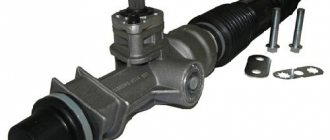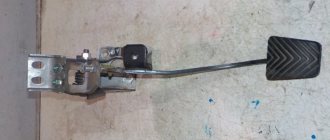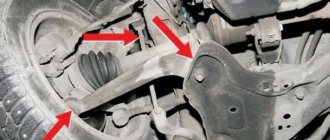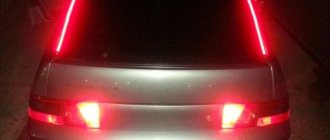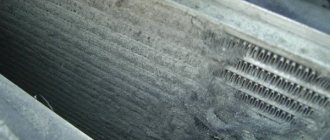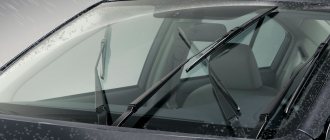Creaking when turning the steering wheel is a problem that every driver faces. Some people notice extraneous sounds immediately, others realize this after several years of continuous use of the car. Squeaks are often common causes of breakdown or malfunction of a mechanism. Problems show themselves under certain circumstances. In our case, this occurs when turning the steering wheel. Let's consider what causes exist, as well as methods for eliminating an unpleasant squeak.
Creaking when turning while moving and standing still
While driving, sooner or later the driver hears various sounds coming from different sides of the car. The creaking of the steering wheel is the most annoying, and the sound can appear completely suddenly and disappear just as quickly. You can protect yourself from various noises in the cabin by installing sound insulation. However, this does not change the fact that sooner or later the squeak will have to be eliminated.
The steering rack usually squeaks when turning. Noises occur both at speed and “in place.” Experts say that the steering wheel must turn silently. And if the driver hears creaks, then you need to immediately find out their source of origin. All that is acceptable in this situation is a slight hiss, and other sounds are completely unacceptable.
Tie Rod Ends
Deformation or rupture of the boots can cause the steering rod to squeak. When sand gets on the mechanism, it clogs the cracks, the lubricant stops working, and a creaking noise occurs. To determine the cause, it is necessary to disconnect the tie rod arms and carefully examine the tip. If foreign objects get in, it is necessary to replace both tips with all components at once. Pair replacement is made in order to increase service life. After replacing the tips, you must contact a car service to perform computer diagnostics and then adjust the wheels (wheel alignment).
The most common causes of a squeaking steering wheel
Many car owners wonder why a squeak is heard when turning the steering wheel; the reasons for this phenomenon are unclear to them. Firstly, you need to understand that a machine that has been in use for more than 10-15 years will in any case make squeaks. This is a natural phenomenon and should not be surprising. Characteristic sounds appear abruptly, they indicate a breakdown or malfunction. It is necessary to eliminate the breakdown as soon as possible, otherwise failure of control at speed or poor steering function will negatively affect driving. Let's look at the most common causes of squeaks.
Incorrect wheel alignment
The wheels themselves can produce an unpleasant grinding noise. There is no need to dismiss this version. If the driver determines that the source of the sound is the tires, then the fault is not hidden in the steering wheel, but in the incorrect wheel alignment. This indicates that the tread wears unevenly, which is not good for the tires in general. Based on this “symptom,” the master is able to determine the need to set angles.
The reason for the squeak in this situation is very simple - an incorrectly aligned wheel touches the locker or other body part. If you ignore the problem, the rubber will wear out faster, which will cause it to fail. It is recommended to set the wheel alignment and check it using special equipment. If a car owner notices this “symptom”, then he needs to visit a tire shop. Electronic equipment will help set the wheel position correctly, and the grinding noise will stop bothering the driver.
Problems with the steering column or rack
A problem with the steering column or rack may cause a grinding noise when turning the steering wheel. In this case, the creaking occurs simultaneously with vibrations on the steering wheel. To better understand the problem, you need to understand how the column works. It is a casing that covers the shaft. Its main purpose is to secure the internal elements and transmit torque to the mechanism. Because of the casing, shocks and vibrations that were not absorbed by the suspension are mitigated.
If the creaking noise when turning the steering wheel is weak, then you can operate the car. But over time, the elements wear out, the creaking intensifies, which means the mechanism requires replacement. As for the steering rack, it is a complex system, especially on cars that were produced a long time ago. The car owner can identify the condition of the anthers, but it will not be possible to conduct a deep diagnosis. For this you need to turn to the experts.
Silent blocks
Silent blocks are elements that can cause the steering wheel to creak. This problem appears during hot weather and now we will explain why. If the air temperature outside is quite high and suddenly the steering wheel begins to creak, then the first thing you need to do is check the silent blocks. This symptom indicates their wear and tear. The parts are made of rubber. During the heat, the rubber dries out, thereby shrinking, especially if it is already old. This is what makes the driver hear the squeak. Fortunately, modern silent blocks on cars are made of polyurethane. In the heat it does not dry out, which means it does not make squeaks.
Bearings
Once the bearings fail, they begin to make strange noises. The driver hears a crackling sound, as well as a squeaking sound when he turns the steering wheel. Sounds occur when the lubricant runs out inside or dirt gets in. This accordingly reduces the resource of the element. To be more precise, the noise is made by the wheel bearing. It lasts about 50-150 thousand kilometers. The specific figure depends on the make of the car, but the front elements wear out faster.
Plastic creaking
Any budget car, unfortunately, makes squeaks by default. This is normal for the economy car segment. This cannot be avoided, since the quality of the plastic and fasteners is poor. 2 years after purchasing a new car, the driver already notices a grinding noise, and with regular use, this sound manifests itself even earlier. You can eliminate squeaks using Madeline. You can carry out the procedure yourself, but it will take a lot of time. It is best to first fix the loose elements and only then carry out processing.
CV joints and ball joints
The ball joint generates squeaks if it wears out. In addition, the driver can hear knocking noises in any steering wheel position. Experts advise replacing the support immediately, as it can fail at the most inopportune moment. If the owner operates the car correctly and does not practice extreme driving, then the ball joints will serve him for a long time. At the same time, you need to keep an eye on the condition of the anthers. If you keep an eye on these two nodes, you won't hear any squeaks in the near future.
As for the CV joint, it, of course, takes part in transmitting torque from the gearbox to the wheels. The occurrence of crunching and creaking when turning the steering wheel in place makes it clear that the CV joint is gradually failing. The needle bearing makes a strange sound.
Many drivers are interested in which CV joint makes the crunching noise. In fact, CV joints are internal and external. The second option crunches more often. If the car enthusiast understands that the problem lies with him, then there is no need to worry. You can replace it after driving another 5-10 thousand kilometers. During diagnostics, it is also possible that the part will not have to be changed - the solution to the problem may be a simple replacement of the boot or updating the lubricant.
Rubber creaking
Rubber squeaks are not such a popular problem, but they do occur. The problems lie in the design of the machine. To find out where the sound is coming from, the car is placed on an overpass, and then they look for the fault itself. The most common sources of grinding noise are silent blocks, wheels or seals.
Power steering malfunction
The power steering system consists of a steering gear, pump, hydraulic lines and reservoir. A malfunction can affect any of the above elements, and the incorrect operation of even one of them negatively affects the operation of the others. The owner of a vehicle cannot always determine exactly what has gone wrong.
The first component that often fails is the steering mechanism. Characteristic symptoms of its damage include:
• Leaks.
• Knocking noise when driving on uneven surfaces.
• Uneven support (different support force when turning the steering wheel left and right).
• Complete lack of support when turning the steering wheel in one or both directions.
• The appearance of the support is delayed, only some time after turning on the car, in hot oil.
• The steering wheel does not return after turning the wheels.
A hydraulic booster is something that every modern car has today. If the owner hears a squeaking noise when turning the steering wheel while driving, then the problem may be with the power steering. It turns the steering wheel into a wheel that rotates softly and smoothly. But when the power steering is faulty, the steering wheel makes strange sounds and squeaks. On the one hand, the problem may not be serious. For example, when the belt has weakened and lost its elasticity. But on the other hand, noise can be caused by a small amount of fluid in the power steering. Then the sounds are heard “on the spot”, and not while driving.
And the most serious problem is a malfunction of the pump or other parts of the amplifier. It is this problem that requires immediate professional intervention.
In this situation, symptoms may include the following:
• the appearance of foam in the booster;
• flow of power steering fluid from the reservoir;
• steering wheel jamming;
• loud operation of the pump when moving forward;
• humming or knocking noise when turning;
• less steering resistance with increasing speed;
• no assistance when turning the steering wheel in both directions.
It should be remembered that symptoms of a malfunction are not always clear signals. It happens that they will be almost invisible, and the power steering system will suddenly begin to refuse to obey. Regardless of the reason, a driver should under no circumstances attempt to repair a vehicle themselves without proper knowledge and experience in this area. By using the services of a specialized workshop, the driver can be sure that not only the malfunction will be properly diagnosed, but also, if necessary, repaired on site with a guarantee.
Noises from power steering
Despite the fact that electric power steering is being introduced very often today, the main driver assistant when steering in most passenger cars remains power steering. This unit may make noise due to a lack of working fluid. In this case, you need to add it to a tank specially designed for this purpose. Just add the same liquid that the manufacturer used, the amplifier itself is configured specifically for the operating parameters of a particular product, and the use of a different liquid can be very negatively perceived by the amplifier. In addition to the lack of working fluid, the cause of noise in the power steering can be its pump, if it is about to die, you also need to check the condition of the power steering belt, because certain difficulties can also arise with it. And if the condition of the power steering belt makes you suspicious, it is better to replace the belt.
Other reasons
When the driver realizes that his steering wheel is creaking when turning, he begins to look for the cause. However, the malfunction may lie in different elements of the car system. Specific car brands have their own specific reasons, which are not discussed in this article. The variety of steering systems is so great that there are many causes of malfunction.
In any case, whatever the cause of the problem, it must be eliminated as soon as possible. And it will be good if a professional does this. It's best to see a mechanic as soon as you notice any warning signs that could indicate a problem with your power steering or other critical components. Underestimating minor problems can lead to their aggravation and complete destruction of the system, which is associated with expensive repairs.
The plastic casing creaks
Every driver knows that when actively using a car that is not of the best build, “crickets” will appear over time. They represent creaks of the front panel, including the steering casing, made of plastic. This problem is solved in various ways, depending on the car model.
If all the parts described above have been inspected and the cause of the squeak cannot be determined, it is also recommended to check the power steering drive belt and brake elements, especially the pads and discs.
How to determine the cause?
Unfortunately, not every driver can easily determine the cause of the squeak. This is almost impossible to do without a thorough diagnosis. Sounds appear when one or more elements of the car system are not working properly. It is quite difficult to understand which part is “capricious”.
Before going to the workshop, you need to pay attention to the following points:
1. What type of sound is heard.
2. The circumstances under which sound occurs.
3. Is the creaking heard regularly or does it appear at certain moments?
4. Are there any other problems with the sound?
All these symptoms need to be told to the technician so that it is easier for him to understand the operation of the machine. The easier it is to identify a problem, the faster it can be eliminated.


